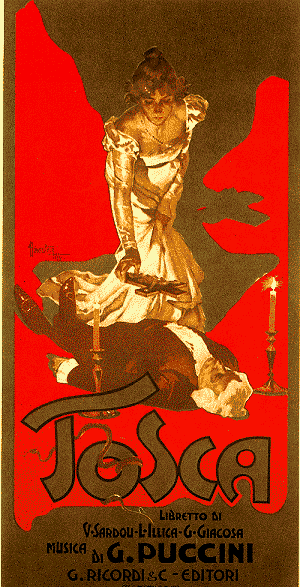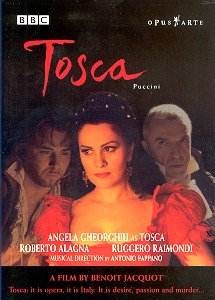"Tosca: it is opera, it is Italy.
It is desire, passion and murder ..." So gushes the front
album cover, whilst the back quotes the Guardian saying that this
film "brings this opera vividly to life ... this is a classic
of the future." Thus my anticipatory set was to tear it to
shreds if at all possible. In this I was aided and abetted by
Benoît Jacquot the director who has done some odd things
with this film and started my viewing by not only failing to bring
the opera to life but by accompanying Puccini’s huge opening chords
with grainy monochrome scenes of the studio recording taking place.
However, a big ‘however’, by the time I had watched
the entire DVD, replayed some extracts and then re-listened without
pictures to the whole of Act 1 I felt that destruction would be
very misleading because this just might be a classic of the future
just as the Guardian says. My advice to first time viewers is
to start with the extras, the three interviews detailed
below, and not the opera, so that you do not have to suffer
the shocks I did. Normally I would allow a DVD opera to suffer
as it deserves, because the majority of weird opera productions
on video do little to rescue themselves from directorial whimsy
and conceptual mistakes. This one is so well sung, so well played,
so well directed, so well acted, so well conducted, and looks
so sumptuous that it has to be seen, and seen repeatedly.
Scenically it is spectacularly good, with huge
views inside the supposed Church of Sant’Andrea della Valle and
some impressive shots outside the Castel Sant’Angelo as well.
As a visual experience this DVD is often very beautiful. Everyone
acts and sings their hearts out but I must make especial mention
of a heart-stopping "Vissi d’arte" from Gheorgiu, and
of the fearsome evil of Raimondi’s Scarpia. The small role of
Spoletta is very well acted (and sung) and adds greatly to the
drama. I am a little less convinced by the performance of Alagna
as Cavaradossi because he looks less at ease in front of the cameras
than his fellows.
In the interviews Gheorgiu talks about her attitude
to filming as opposed to staging the work, how her acting has
to be adjusted, how much more facial expression matters. She comes
over as a very thoughtful performer indeed. The film director
explains why he went for the stage to studio inter-cutting. He
wanted to show the singers singing as well as miming, not a bad
rationale. He intended the film to mix documentary and fiction
and states that though he dislikes many of his own films after
completion, this one he likes. The conductor Antonio Pappano talks
of the "blood and guts" kind of opera this is and of
Puccini’s "hair-trigger response" to the words. He also
notes that Puccini was one of the great inspirations of film music
in the 20th Century. Pappano admits to slowing down
more than he would in the theatre, something I noted in the performance
but not to its detriment. There is something Wagnerian about the
huge power of this masterly score.
There are problems and they should be enumerated.
By mixing opera performance and film of the studio
recording two problems arise, scenic dislocation and lip synchronisation
errors. The music was recorded before the film was made and so
these singers had to mime to themselves some time later. They
make a variable job of this but in general I would give them 7/10.
The stereo sound track is labelled PCM but don’t be fooled into
thinking it is as good as CD; it isn’t. It sounds dynamically
compressed and at times spatially crowded. The middle of Act 2
goes very recessed when Tosca is trying to comfort Cavaradossi
after his torture by Scarpia’s men. At the same time as the voices
go distant the pictures are close up. The orchestra suffers throughout
the stereo mix. The DTS sound is much better and though probably
not very realistic it does sound impressive. Sound effects are
prominent on many occasions but since this is theatre one must
allow audio theatricality. After all we did not complain when
John Culshaw used a sine wave generator to underpin the great
opening chord of Das Rheingold for Decca in 1958.
The prelude to Act 3 is accompanied by previous
scenes of the story run backwards. Gorgeous though Gheorgiu is,
even she looks strange running backwards! The studio inter-cutting
and the scenes of the Castel Sant’Angelo are intentionally grainy
and provide an odd contrast with the superb images of the actual
opera. At one point the characters speak their lines into the
mics whilst singing in the background. At the end of the opera,
Tosca having leapt to her death from the battlements, the final
thunderous chords are heard against a visual of Gheorgiu’s face,
filmed in the studio, clearly transfixed by the drama of the moment.
When the music is over, she relaxes with a soto voce "ooh!"
of released tension. How much repetition this would bear I am
not sure but Gheorgiu says she approved Benoît’s decision
to include that clip. Also after the opera is over the end titles
are run over a repeat of the prelude to Act 2, which is musically
disturbing. The on-screen DVD "chapters" do not include
the starting points of Acts 2 and 3, one has to cross reference
with the booklet to isolate these.
As I said at the start I did so want to pan this
DVD because of its production values but I kept coming back to
it and was ultimately won over because everyone is so committed
and it is just so overwhelmingly dramatic an experience. There
is not much serious competition on video until the "filmed
on the spot" performance by Domingo and Mehta arrives on
DVD (nasty old VHS tape only I’m afraid). On CD I would go for
Sinopoli on DG and of course the old Callas which remains nonpareil.
With reservations then, you have to see this!
Dave Billinge



